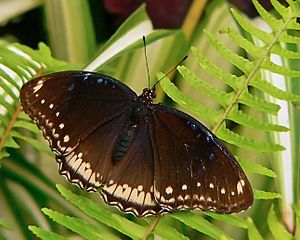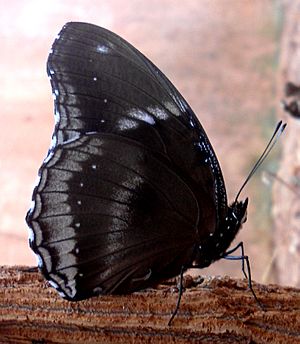Great eggfly facts for kids
Quick facts for kids Great eggfly |
|
|---|---|
 |
|
| Male | |
 |
|
| Female | |
| Scientific classification | |
| Subspecies | |
|
Eight, see text |
|
| Synonyms | |
|
The great eggfly (also known as the common eggfly or blue moon butterfly in New Zealand) is a type of butterfly. Its scientific name is Hypolimnas bolina. You can find this butterfly in many places, from Madagascar all the way to Asia and Australia.
Contents
Appearance
The great eggfly butterfly has a black body. Its wings can spread about 70 to 85 millimeters wide. This butterfly shows a lot of sexual dimorphism. This means the males and females look very different from each other. The female great eggfly can even look like other butterflies!
Male Butterflies
Male great eggfly butterflies always look the same. Their top wings are a shiny jet black. They have three bright spots: two on the front wings and one on the back wing. To our eyes, these spots look white with a blue-purple edge. But these spots actually have a special white center that glows with bright ultraviolet light. This amazing color comes from tiny structures on their wing scales. You can also see many smaller white spots along the edges of their wings. The underside of their wings is brownish with white stripes and does not have the glowing ultraviolet colors.
Female Butterflies
Female great eggfly butterflies can look very different from each other. This is because of their genes and how they grow up. Their top wings can have different patterns of white, orange, and blue markings. One type of female looks very similar to other butterflies from a group called Euploea. This helps them stay safe from predators. The underside of the female's wings looks a lot like the male's. Also, if a female butterfly grows up in cooler weather, her wings will usually be darker.
Gallery
-
Hypolimnas bolina in Cooktown
Where They Live
You can find the great eggfly butterfly in many parts of the world. They live in Madagascar in the west. From there, they spread across South and Southeast Asia, Cambodia, and many South Pacific islands. These islands include French Polynesia, Tonga, Tuvalu, Samoa, and Vanuatu. They are also found in parts of Australia, Japan, and New Zealand.
Sometimes, great eggflies fly to New Zealand. This usually happens when strong winds blow them there from Australia between April and June. They have been seen in New Zealand in 1956, 1971, and 1995. However, they haven't made permanent homes there.
Habitat
The great eggfly is a common butterfly in most warm, wet, and dry places. This includes open woodlands, rainforests, and shrublands. They often visit suburban gardens and other areas where people live. In Australia's tropical regions, you can often spot them along paths, near streams, and in areas between forests and sugar cane fields. Both male and female butterflies are usually found near the plants their caterpillars like to eat. These plants often grow in disturbed areas, like Synedrella nodiflora, Sida rhombifolia, and Commelina cyanea.
Mimicry
In the western parts of their range, female great eggflies look like other butterflies from the Euploea group. This is a clever trick called Batesian mimicry. It means they copy the look of a butterfly that tastes bad to predators. This helps the great eggfly avoid being eaten, even though they might taste fine! Further east, the great eggfly females often have many different looks and don't always mimic other butterflies.
Life Cycle and Habits
Male great eggfly butterflies like to protect their own space. They can stay in the same spot for up to 54 days, guarding it from other males. They choose spots where they can easily see female butterflies.
Female great eggflies usually lay one or two eggs at a time. They often place these eggs on the underside of a leaf. Early in the season, females in Australia will look for fresh young plants of Synedrella nodiflora to lay their eggs on. The eggs hatch after about three days if the temperature is around 25 degrees Celsius.
Host Plants
The caterpillars of the great eggfly eat several different plants. Some of their favorite plants include Sida rhombifolia, Elatostemma cuneatum, Portulaca oleracea, Laportea interrupta, Triumfetta pentandra, and Asystasia species. They also feed on Elatostema cuneatum, Fleurya interrupta, Pseuderanthemum variabile, and Synedrella nodiflora. Sometimes, they eat Urtica dioica and Malva species. Adult butterflies in New Zealand have been seen drinking nectar from plants like Lantana, Grevillea, Hebe, Symphyotrichum novi-belgii, and Solanum muricatum.
Eggs
The eggs of the great eggfly are a light, clear green color. They have ridges running down their sides, but the very top is smooth.
Caterpillar
After about four days, the eggs hatch into tiny caterpillars. The caterpillars quickly spread out. They are black with an orange head and an orange last body part. Their heads have two long, branched black horns. Their bodies are covered with long, branched, orangish-black spines. When they first shed their skin (a process called molting), these spines look whitish and clear, but they soon turn orange. In older caterpillars, the breathing holes (spiracles) on their sides have thin, dirty orange rings around them. Interestingly, a type of bacteria called Wolbachia can infect these caterpillars and only kill the male ones.
Pupa
The caterpillar then turns into a pupa, which hangs upside down by a single point. The pupa is brown with a grayish tint on the wing parts. Its body segments have small bumps. The surface of the pupa feels rough. After about seven to eight days, the butterfly emerges from the pupa. Female butterflies usually take a little longer to develop.
Amazing Evolution Story
On the Samoan Islands of Upolu and Savai'i, something amazing happened to the great eggfly butterflies. A tiny parasite, likely a type of Wolbachia bacteria, was killing almost all the male butterflies. By 2001, only 1% of the great eggfly population were males!
But then, something incredible happened. By 2007, in just about five years (which is only 10 generations for butterflies), the male butterflies had developed a way to fight off the parasite! Their bodies evolved to become immune to it. Because of this, the number of males quickly went up to almost 40% of the population. This super-fast change happened because of a small change in just one part of their DNA. It's one of the quickest examples of natural selection (where living things adapt to their environment) ever seen in nature!
Subspecies
The great eggfly has many different types, called subspecies, found in various locations. Some of these include:
- H. b. bolina (found in places like Sumatra, New Guinea, Australia)
- H. b. nerina (found in Timor, northern Australia, New Zealand)
- H. b. philippensis (found in the Philippines)
- And many others across Asia and the Pacific islands.








